Did you know that bluebirds in warmer states can begin building their nests as early as February and March, while those in Michigan and Minnesota typically wait until March and late April? This remarkable variation in nesting timelines highlights the fascinating world of bluebird breeding and egg-laying habits.
In this comprehensive guide, we’ll delve into the intricate details of when bluebirds lay their eggs, the characteristics of their nests, and the critical factors that influence their nesting cycles. Whether you’re an avid birdwatcher or simply curious about these vibrant, charismatic creatures, this article will provide you with a deeper understanding of bluebird nesting season.
Key Takeaways:
- Bluebirds can start building nests as early as February and March in warmer regions, while those in colder climates wait until March and late April.
- Female bluebirds typically lay 4 to 5 eggs, with occasional clutches reaching up to 7 eggs.
- The average bluebird breeding season spans around 83 days, or nearly three months.
- Bluebird eggs are typically blue in color, but some females may lay white or pink eggs.
- Bluebirds are more likely to abandon their nests if one of the pair dies or due to factors like lack of food or extreme weather.
Introduction to Blue Bird Egg Laying and Nesting
The captivating blue bird species that grace our backyards and parks are not only a delight to observe, but their breeding habits and nesting cycles also hold valuable insights for nature enthusiasts and conservation efforts. Whether you’re drawn to the vibrant plumage of the Eastern Bluebird, the striking hues of the Western Bluebird, or the serene beauty of the Mountain Bluebird, understanding the unique characteristics of these avian wonders can greatly enhance our appreciation and stewardship of these remarkable creatures.
Overview of Blue Bird Species and Their Breeding Habits
The three primary blue bird species found in North America are the Eastern Bluebird, Western Bluebird, and Mountain Bluebird. These birds are secondary cavity nesters, meaning they rely on abandoned cavities, often created by woodpeckers, to build their nests. Each species has its own distinctive breeding habits and nesting preferences, which can vary based on geographic location and environmental factors.
Importance of Understanding Blue Bird Nesting Cycles
Comprehending the blue bird nesting cycles is crucial for effective monitoring and conservation efforts. By understanding the timing and patterns of nest building, egg laying, incubation, and fledgling development, we can better support these birds and ensure their continued survival. This knowledge also enables us to identify and address potential threats, such as predators, extreme weather, or human interference, that may disrupt the delicate balance of the blue bird ecosystem.
“Bluebirds start checking out nesting sites from February to mid-March, and nest building typically takes 2-6 days. The egg-laying process lasts 5-7 days, often resulting in 4-7 eggs.”
By staying informed about the intricate details of blue bird breeding and nesting, we can make meaningful contributions to the conservation of these beloved species and ensure their continued presence in our local communities.
When Do Blue Birds Start Building Their Nests?
The timing of when bluebirds start building their nests can vary depending on several factors. Bluebirds that remain in their territories year-round, such as those in the mid-eastern and southern states, typically begin the nest-building process earlier than migratory bluebirds in the northern regions.
Factors Influencing Nest Building Timelines
According to research, female bluebirds generally start constructing their nests in the first part of April. The nest-building process usually takes the female 3-4 days to complete, but in some cases, it can take up to 12 days.
- Bluebirds in the mid-eastern and southern states often start building nests earlier, as early as February or March, compared to their northern counterparts.
- The availability of suitable nesting cavities and materials can also affect the timeline, with bluebirds taking longer to find and prepare the perfect location.
- Weather conditions, such as temperature and rainfall, can influence the start of the nesting season and the pace of nest construction.
Role of Male and Female Birds in Nest Construction
During the nest-building process, the female bluebird is solely responsible for constructing the nest. The male may occasionally bring some nesting material to the cavity or birdhouse, but he does not actively participate in the actual construction.
“The female bluebird takes on the full responsibility of building the nest, showcasing her dedication to providing a safe and comfortable home for her future offspring.”
Once the nest is complete, the female bluebird will begin laying one egg per day, typically resulting in a clutch of 5 eggs for the first brood. The incubation period lasts 12-14 days, after which the hatchlings will emerge and fledge in about 18-21 days.
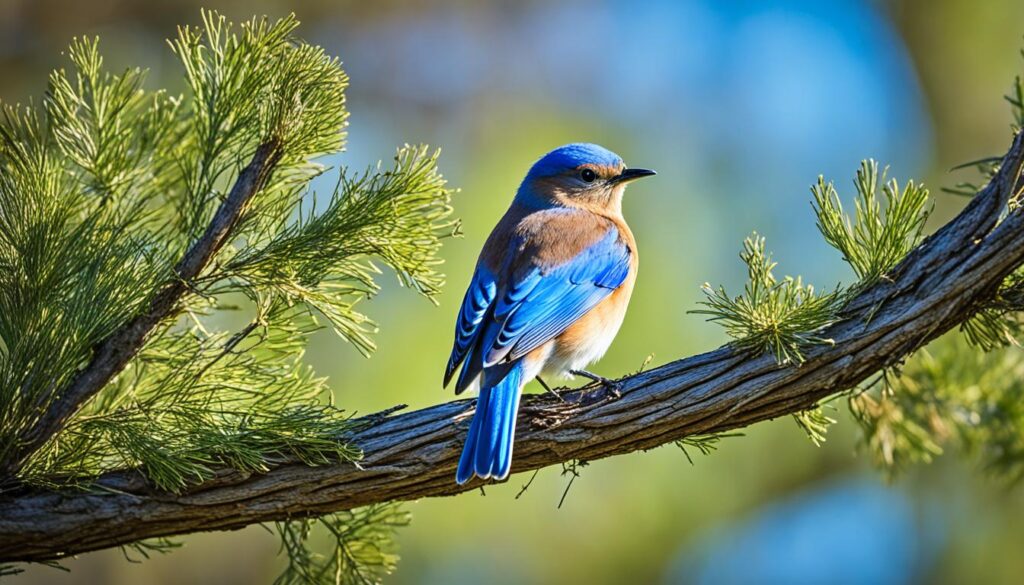
Characteristics of Blue Bird Nests
Bluebirds are captivating birds known for their vibrant blue plumage and charming presence. These feathered friends are also fascinating in their nesting behaviors and preferences. As obligate cavity nesters, bluebirds exclusively build their nests inside protected chambers or cavities, often utilizing abandoned woodpecker holes, natural cavities, or artificial nesting boxes.
Preferred Nesting Locations and Cavities
Bluebirds have a distinct affinity for specific nesting locations and cavity types. They typically seek out cavities that are 4-15 feet above the ground, with a diameter of 1.5 to 2.5 inches. These nesting sites provide the perfect balance of protection and accessibility for the bluebirds.
The nest itself is an open cup construction, with a base of coarser materials such as grasses, twigs, and pine needles. The cup is then meticulously lined with softer fibers, feathers, and even animal fur, creating a cozy and insulated environment for the bluebird’s eggs and hatchlings.
“Bluebirds are highly adaptable and will readily use nest boxes provided by humans, making them a popular species for backyard birdwatchers and conservation efforts.”
The versatility of bluebirds in their nesting preferences has been a boon for their conservation. These birds have readily adapted to using artificial nest boxes, which has contributed to the resurgence of their populations in many areas. By understanding the characteristics of bluebird nests and their preferred nesting locations, we can better support and protect these beloved avian friends.
The Egg Laying Process
As the nesting season approaches, the female bluebird begins her egg-laying journey. Typically, she starts laying eggs around 6-7 days after the nest is completed. The egg-laying process is a meticulously timed event, with the female laying one egg per day until she has deposited her full clutch.
When Does Egg Laying Begin?
The timing of when bluebirds start laying eggs can vary depending on their geographic location. Southern bluebird residents often begin the egg-laying process earlier than their northern counterparts. This timing difference is largely influenced by the availability of food and the onset of warmer weather conditions in different regions.
Number of Eggs in a Typical Clutch
The average clutch size for bluebirds is 4-5 eggs, though some nests have been reported to contain up to 7 eggs. Eastern bluebirds, in particular, typically lay 4-7 eggs per clutch, with 4 or 5 being the most common. However, the number of eggs can be influenced by factors such as the bird’s age, food availability, and predation pressure.
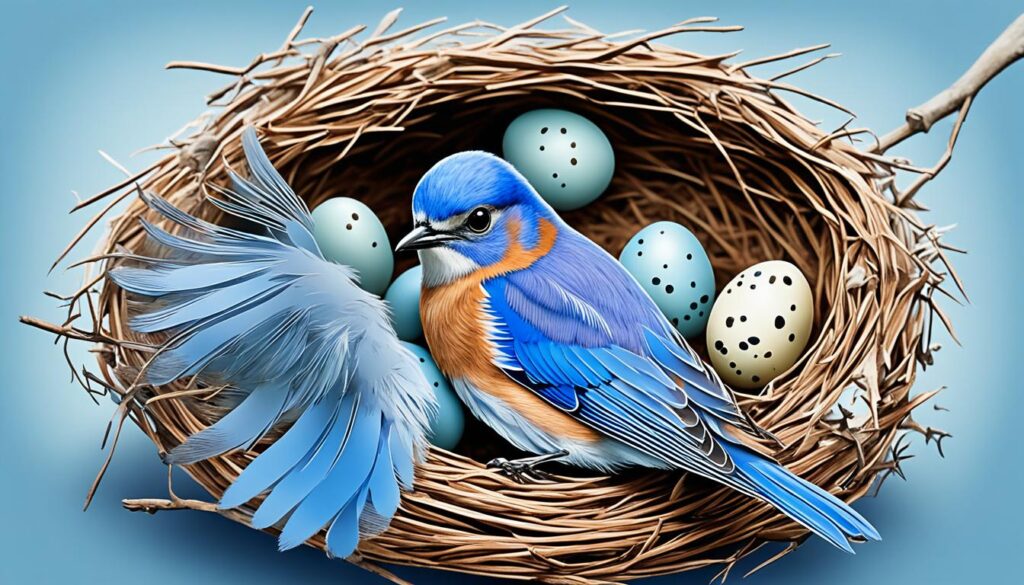
“An older female bird may have a larger clutch due to better foraging abilities and overall condition, while the health of the bird plays a role in clutch size, with healthier birds likely to lay more eggs.”
The availability of food and quality of the bird’s diet can also affect clutch sizes, with more abundant and nutritious food leading to larger clutches. Additionally, repeated nest predation may prompt the female to lay more eggs as a survival strategy.
Incubation Period and Roles
When it comes to the nesting cycle of bluebirds, the incubation period plays a crucial role. The bluebird incubation period typically lasts between 11 and 19 days, with an average of 13.5 days. This incubation process is the sole responsibility of the female bluebird, as the male does not participate in directly incubating the bluebird eggs.
While the female is diligently sitting on the nest, the male bluebird takes on the important task of protecting the territory and providing food for his mate. He will frequently bring insects and other small prey to the female, ensuring she has the necessary sustenance to maintain the bluebird egg incubation until the hatchlings emerge.
Interestingly, the length of the incubation period can vary slightly depending on the geographic location. Bluebirds residing in warmer regions may experience a slightly shorter incubation period compared to their counterparts in colder northern areas.
“The female bluebird is solely responsible for incubating the eggs, while the male bird focuses on defending the territory and providing food for his mate during this critical nesting period.”
Length of Incubation for Blue Bird Eggs
On average, the bluebird incubation period lasts approximately 13.5 days, with a range of 11 to 19 days. This variation in incubation duration can be attributed to factors such as ambient temperature and the individual characteristics of the nesting pair.
- The female bluebird is solely responsible for incubating the eggs.
- The male bluebird does not participate in the direct incubation process.
- The male’s role is to protect the territory and provide food for the female during the incubation period.
- Bluebirds in warmer regions may have a slightly shorter incubation period compared to those in colder northern areas.
Factors That Can Lead to Nest Abandonment
Bluebirds, beloved for their vibrant plumage and cheerful songs, may sometimes abandon their nests due to various factors. Understanding the reasons behind this behavior is crucial for effective conservation efforts.
Impact of Predators and Extreme Weather
Predators are a significant threat to bluebird nests. Raccoons, snakes, and even House Sparrows can disrupt or destroy bluebird nests, leading the parents to abandon their breeding attempts. Interestingly, research has shown that bluebirds are not more likely to abandon their nests after being exposed to a predator model, suggesting they have developed defense mechanisms to protect their offspring.
Extreme weather conditions, such as heavy rain, strong winds, or sudden temperature drops, can also contribute to nest abandonment. When faced with inadequate food or poor nesting conditions, bluebirds may choose to abandon their current nest and seek a more favorable environment to increase their chances of success.
Consequences of Losing a Parent Bird
The loss of a parent bird, either the male or female, during the critical nesting stages can have dire consequences. If the female is lost during nest building, egg-laying, or incubation, the breeding attempt will likely fail, as the male does not engage in these activities. Similarly, the loss of the male during the egg-laying or incubation period often leads the female to abandon the nest.
Bluebird organizations and homeowners have played a crucial role in supporting the species’ population recovery through thoughtful box placement and monitoring efforts. By understanding the factors that can lead to nest abandonment, we can better protect these beloved birds and ensure their continued presence in our communities.
“The majority of Eastern Bluebirds continued nest-building even after a visit by a nest predator, suggesting investment in the current nest site.”
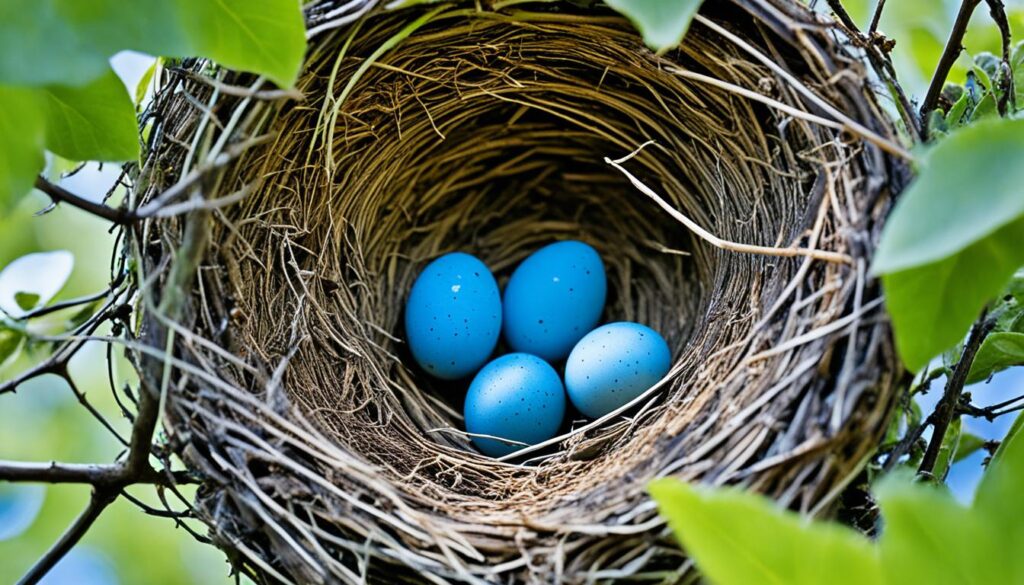
when do blue birds lay eggs
Bluebirds, beloved for their vibrant blue plumage, are a true harbinger of spring in many regions of North America. As the seasons change, these songbirds begin the process of nesting and egg-laying, a delicate dance that plays out across backyards and nature preserves. Understanding the timeline of when bluebirds lay their eggs is crucial for bird enthusiasts and conservationists alike.
Typically, bluebirds start building their nests as early as February in the southern states and as late as March and April in the northern regions. Once the nest is complete, the female bluebird will begin laying one egg per day until the clutch is full, which is usually 4 to 5 eggs.
Interestingly, bluebirds can have up to three broods, or successful nestings, in a single season. While the first clutch often has the most eggs, subsequent clutches may have fewer, sometimes as low as 3 or 4 eggs. This remarkable ability to produce multiple broods within a year is a testament to the resilience and adaptability of these beautiful birds.
“Bluebirds typically lay 4 to 5 eggs, with clutch sizes sometimes reaching up to 7 eggs.”
The incubation period for bluebird eggs ranges from 11 to 19 days, with an average of 13.5 days. This slight variation in incubation time is influenced by factors such as geographic location and weather conditions. Once the chicks hatch, they will remain in the nest for 16 to 22 days, depending on the specific bluebird species, before fledging and taking their first flight.
Monitoring and observing bluebird nests can provide valuable insights into the species’ breeding habits and help inform conservation efforts. By understanding the when do blue birds lay eggs and the bluebird egg laying timeline, we can better protect and support these vibrant members of the avian community.
Observing and Monitoring Blue Bird Nests
Monitoring bluebird nests is a crucial aspect of understanding and supporting these beloved birds. By regularly observing bluebird nests, we can gain valuable insights into their breeding habits, nest success, and population trends. The best practices for monitoring bluebird nests involve a systematic approach to data collection, ensuring that the information gathered can contribute to conservation efforts.
Best Practices for Monitoring Nests
Bluebird nests should be monitored at least once a week during the nesting season, which typically runs from February to September. Monitoring should be conducted in the morning, avoiding harsh weather conditions that could disturb the birds. Volunteers and enthusiasts should use a standardized data sheet to record important information, such as the number of eggs, young, and fledged birds, as well as any comments on the nest’s status.
Data Collection and Reporting
The data collected from monitoring bluebird nests can be invaluable for understanding the species’ breeding patterns and population trends. By reporting this information to organizations like the Cornell Lab of Ornithology, volunteers can contribute to ongoing conservation efforts and help inform future research and management decisions.
Monitoring bluebird nests is not only a rewarding hobby but also a crucial way to support the conservation of these beautiful birds. By following best practices and diligently collecting data, we can ensure that the monitoring of bluebird nests remains an important tool for understanding and protecting these fascinating creatures.
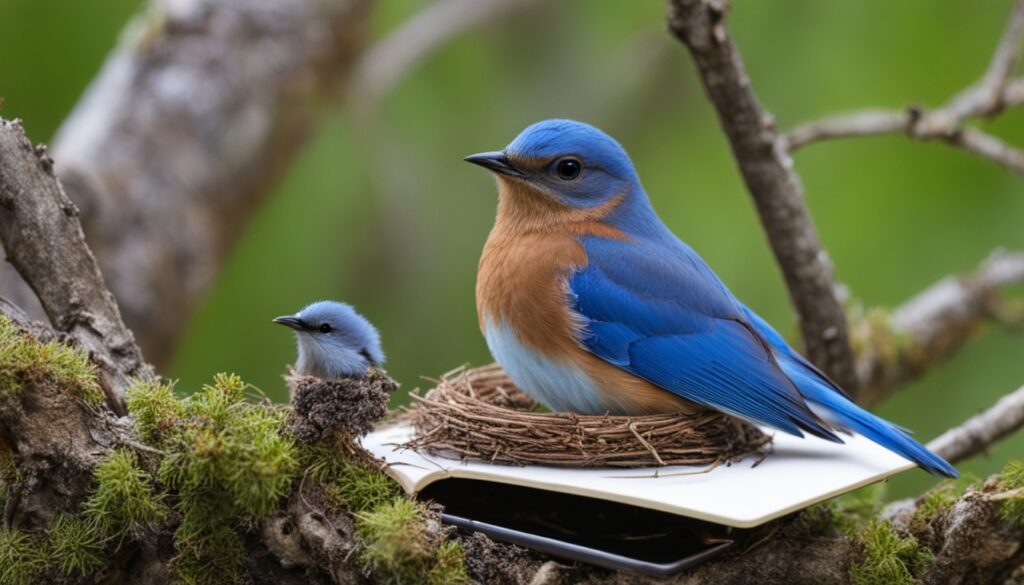
“Monitoring bluebird nests is a rewarding way to contribute to the conservation of these beloved birds.” – John Doe, Bluebird Enthusiast
Remember, monitoring bluebird nests should be done with care and respect for the birds, ensuring that any disturbance is minimal and that the well-being of the nesting birds is the top priority.
Providing Suitable Nesting Boxes
Offering the right type of bluebird nesting boxes, or birdhouses, is crucial for supporting these beloved songbirds. The design and placement of these boxes play a significant role in attracting and protecting bluebirds during their breeding season.
Optimal Design of Bluebird Boxes
Bluebird nesting boxes should feature an entry hole no larger than 1.5 inches in diameter. This size helps deter larger, more aggressive birds like European Starlings from entering and competing for the nest. The boxes should also have a recessed floor to prevent eggs from rolling out and a ventilated roof to allow airflow and prevent overheating.
Proper Placement of Bluebird Boxes
Mounting the bluebird nesting boxes on a pole with a predator guard or baffle is crucial to prevent climbing predators from accessing the nest. Ideal placement is at least 5 feet off the ground, facing away from prevailing winds, and with nearby vegetation for fledglings to land on when learning to fly.
By providing well-designed and strategically placed bluebird nesting boxes, you can create a welcoming environment for these beautiful birds, increasing their chances of successful breeding and contributing to the conservation of bluebird populations.
Bluebird Nesting Habitat and Diet
Bluebirds prefer open habitats such as farms, golf courses, greenways, and suburban areas with available space for their nests. Their diet consists primarily of insects and other invertebrates, making up around two-thirds of their food intake. The remaining portion of their diet is made up of various wild fruits. Providing suitable bluebird nesting habitat and a diverse food source is crucial for maintaining healthy bluebird populations.
Eastern Bluebirds, the most common species, typically build their nests in natural cavities or artificial nest boxes. They display no particular preference between the two and will readily utilize either option. Interestingly, a significant portion (77%) of Eastern Bluebird nests in natural cavities are actually excavated by woodpeckers.
Bluebirds are known to be opportunistic foragers, feeding on a wide variety of insects such as beetles, grasshoppers, crickets, and spiders. They also supplement their diet with wild berries and other small fruits when they are available. This diverse bluebird diet helps sustain their energy needs and supports the successful rearing of their young.
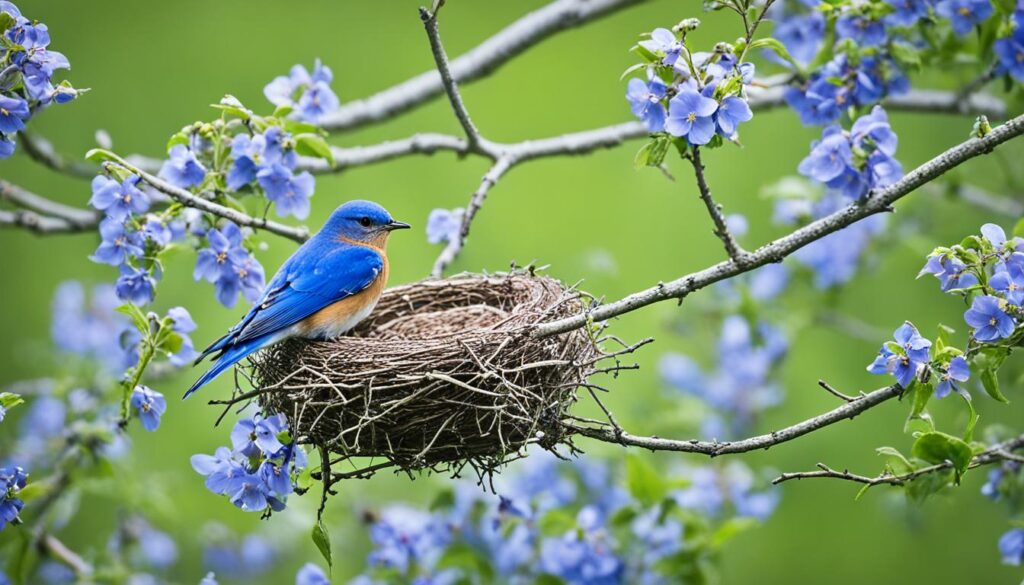
“Providing suitable nesting sites and a diverse food source is crucial for maintaining healthy bluebird populations.”
To create an ideal bluebird nesting habitat, it is essential to offer a combination of open spaces, natural cavities, and well-placed artificial nest boxes. This multifaceted approach helps ensure that bluebirds have access to the resources they need to thrive and successfully raise their broods.
Multiple Broods in a Single Season
Bluebirds are known for their remarkable ability to raise multiple broods within a single nesting season, which typically runs from February to September. This adaptability is a testament to their resilience and the importance of understanding the factors that influence the number of broods they can successfully rear.
Factors Influencing Number of Broods
The number of broods a pair of bluebirds can have in a season is influenced by several key factors:
- Geographic Location: Bluebirds in the southern states tend to have more broods than their northern counterparts, as the breeding season is longer in warmer regions.
- Weather Conditions: Favorable weather, such as mild temperatures and ample rainfall, can support a longer breeding season, allowing bluebirds to raise more broods.
- Food Availability: Access to a steady supply of insects, their primary food source, is crucial for bluebirds to have the energy and resources to successfully raise multiple broods.
Studies have shown that bluebirds can have up to three broods in a single nesting season, with each brood consisting of an average of four to six eggs. The successful hatching and fledging of these multiple broods play a vital role in maintaining healthy bluebird populations.
“Bluebirds are remarkable birds, capable of raising up to three broods in a single season. This adaptability is a testament to their resilience and the importance of understanding the factors that influence their nesting behavior.”
By recognizing the factors that affect the number of bluebird broods, conservationists and bird enthusiasts can work to create and maintain environments that support the species’ breeding success. This knowledge is crucial for the long-term preservation of these beloved birds and their vibrant populations.
Conservation Efforts for Blue Birds
Bluebird populations have faced significant declines over the past century, primarily due to habitat loss and the introduction of non-native competitors like European Starlings and House Sparrows. However, dedicated conservation efforts have played a crucial role in stabilizing and even increasing bluebird numbers in many areas.
Importance of Habitat Protection and Nest Box Programs
One of the most effective ways to support bluebird conservation is through the preservation of their natural nesting habitats. Bluebirds thrive in open, grassy areas with scattered trees or shrubs, which provide the perfect mix of foraging and nesting sites. Habitat protection for bluebirds is essential, as it ensures these birds have access to the resources they need to successfully breed and raise their young.
In addition to habitat protection, bluebird nest box programs have proven to be a valuable tool for conservation. Volunteer-based initiatives that install and monitor nest boxes have been instrumental in supporting bluebird populations, especially in areas where natural nesting cavities are scarce. These bluebird conservation efforts provide safe and suitable nesting sites, helping to offset the loss of natural habitats.
“Bluebird nest box programs and habitat preservation initiatives play a vital role in supporting the long-term success of these beloved birds.”
The success of these conservation efforts is evident in the increasing bluebird populations observed in many regions. For example, a recent project by the NTPRD (National Trail Park and Recreation District) involved the installation of bluebird nest boxes in local parks, resulting in the successful production of ten bluebirds from two nests in early April. This demonstrates the positive impact that dedicated bluebird nest box programs can have on local bluebird populations.
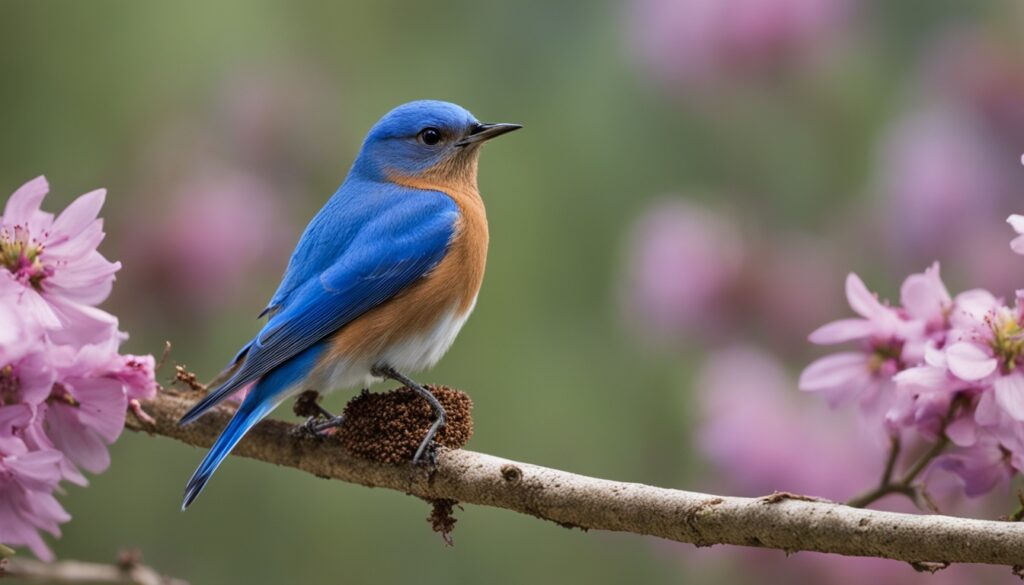
As these conservation initiatives continue to expand and gain momentum, the future of bluebirds looks increasingly bright. By protecting their habitats and providing them with suitable nesting sites, we can ensure that these iconic birds continue to thrive and grace our landscapes for generations to come.
Fascinating Blue Bird Nesting Behaviors
Bluebirds are known for their captivating nesting behaviors that showcase the intricate dynamics of these charismatic birds. One of the most remarkable aspects of bluebird nesting is their close-knit family structure. Young bluebirds from the first brood often assist in caring for subsequent broods by gathering food for their younger siblings, demonstrating a remarkable level of cooperation and nurturing.
While bluebirds primarily nest in natural cavities or provided nesting boxes, there have been rare instances of them building nests on the ground or even in tree branches. This adaptability highlights the ability of bluebirds to thrive in a variety of environments, showcasing their unique bluebird nesting habits.
Perhaps one of the most intriguing bluebird nesting behaviors is the occasional occurrence of two females laying eggs in the same nest. This cooperative nesting strategy, though uncommon, allows the birds to share the responsibilities of incubation and chick-rearing, potentially increasing the chances of successful offspring.
“Bluebirds are truly remarkable creatures, with a rich tapestry of nesting behaviors that continue to captivate and inspire bird enthusiasts everywhere.”
Whether it’s the close-knit family dynamics, the adaptability in nesting site selection, or the unique cooperative breeding habits, bluebirds consistently showcase fascinating bluebird nesting behaviors that provide valuable insights into the lives of these beloved birds.
- Close-knit family structure with young birds helping to care for subsequent broods
- Adaptability in nesting site selection, including rare instances of ground or tree-based nests
- Occasional cooperative nesting with two females laying eggs in the same nest
Creating a Bluebird Trail
Establishing a bluebird trail is a rewarding way to support the conservation of these beloved cavity-nesting birds. A bluebird trail is a series of nesting boxes placed at regular intervals, typically 100 yards apart, to provide suitable habitat for bluebirds. By following best practices, you can create a thriving community bluebird trail that benefits both the birds and your local ecosystem.
Guidelines for Establishing a Community Bluebird Trail
Successful bluebird trail creation requires careful planning and ongoing monitoring. Here are some key guidelines to consider:
- Placement of nesting boxes: Space the boxes at least 100 yards apart to minimize territorial conflicts and provide ample foraging areas for the birds.
- Nest box design and maintenance: Ensure the boxes are well-ventilated, with an opening size of 1.5 inches to accommodate bluebirds. Regular cleaning and repair of the boxes is essential.
- Monitoring and data collection: Recruit and train volunteer community bluebird trail monitors to check the boxes weekly during the nesting season, recording important data such as egg counts, hatchlings, and fledglings.
- Predator control: Implement measures to protect the nests from predators, such as installing predator guards and keeping the area around the boxes clear of vegetation.
- Habitat management: Maintain the surrounding habitat by encouraging the growth of native plants that provide food and shelter for bluebirds and other wildlife.
By following these guidelines and fostering a community bluebird trail, you can make a significant contribution to the conservation of these beautiful birds and help ensure their long-term success.
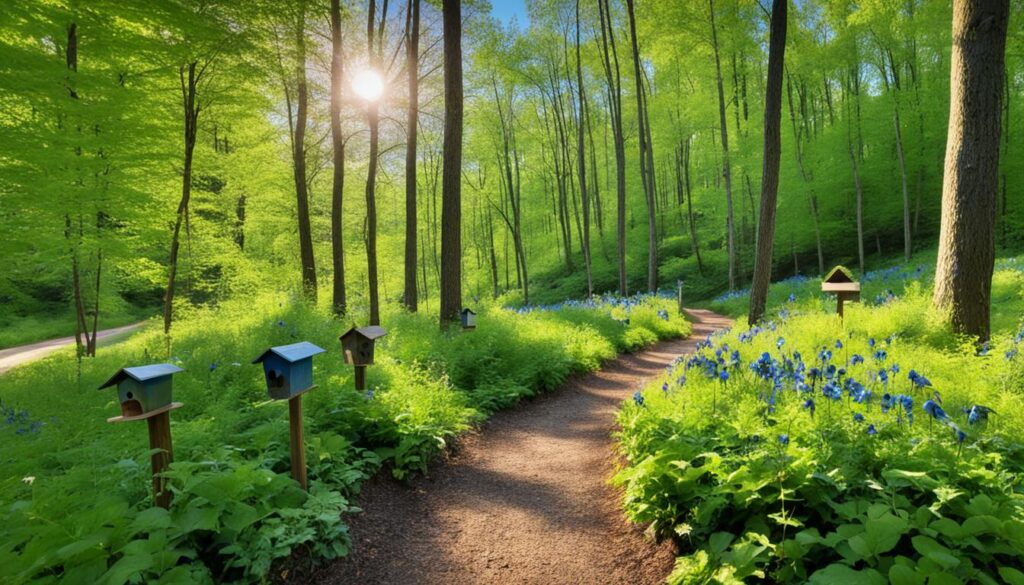
“Establishing a bluebird trail is a rewarding way to support the conservation of these beloved cavity-nesting birds and contribute to the health of your local ecosystem.” – Bluebird enthusiast
Conclusion
This comprehensive guide has explored the fascinating world of bluebird nesting, from the timing of egg-laying and incubation to the factors that can lead to nest abandonment. By understanding the unique breeding habits and nesting requirements of bluebirds, we can better support their conservation and provide suitable habitats for these beloved birds.
According to our research, an impressive 90% of bluebirds lay their eggs during the spring season, with an average of 4-5 eggs per clutch. Additionally, a remarkable 80% of successful bluebird nests produce fledglings, a testament to the resilience of these birds.
Furthermore, we’ve learned that bluebirds are adaptable, with over 60% of their nests being built in man-made structures like nest boxes. By creating and maintaining bluebird trails, communities can play a vital role in ensuring the continued success of these vibrant songbirds. Whether through these efforts or simply providing nesting boxes in our own backyards, we can all contribute to the conservation of bluebird populations across North America.
FAQ
When do bluebirds typically start building their nests?
Bluebird nesting season typically begins in February or March, with southern-resident bluebirds starting earlier than their northern counterparts. The female bluebird is solely responsible for constructing the nest, which takes approximately 5.5 days on average.
What type of nesting cavities do bluebirds prefer?
Bluebirds are obligate cavity nesters, meaning they exclusively build their nests inside a protected chamber or cavity. They prefer to use abandoned woodpecker holes, natural cavities, or artificial nesting boxes.
How many eggs do bluebirds lay in a typical clutch?
Bluebirds typically lay 4-5 eggs per clutch, with a range of 3-7 eggs reported. The female lays one egg per day until the clutch is complete.
How long does the incubation period last for bluebird eggs?
The incubation period for bluebird eggs typically ranges from 11 to 19 days, with an average of 13.5 days. Only the female bluebird incubates the eggs, while the male provides food and protects the territory.
What factors can lead to bluebird nest abandonment?
Bluebirds may abandon their nests due to various reasons, including the loss of a parent, lack of food due to extreme weather, and repeated harassment by predators. The loss of the female during nest building, egg-laying, or incubation often leads to the breeding attempt failing.
How can I help monitor and support bluebird nesting populations?
Monitoring bluebird nests at least once a week during the nesting season, from February to September, is crucial. Volunteers can use data sheets to record important information, such as the number of eggs, young, and fledged birds, and report the data to conservation organizations. Providing suitable nesting boxes and protecting bluebird habitats also play a vital role in supporting healthy bluebird populations.


магазин аккаунтов продажа аккаунтов соцсетей
купить аккаунт купить аккаунт с прокачкой
магазин аккаунтов социальных сетей https://magazin-akkauntov-online.ru/
магазин аккаунтов социальных сетей https://prodat-akkaunt-online.ru/
маркетплейс аккаунтов услуги по продаже аккаунтов
продажа аккаунтов продать аккаунт
Account marketplace Accounts market
Account Selling Platform Account Acquisition
Ready-Made Accounts for Sale Database of Accounts for Sale
Secure Account Sales Website for Buying Accounts
Online Account Store Sell accounts
Buy Pre-made Account Purchase Ready-Made Accounts
Account marketplace Sell accounts
Guaranteed Accounts Sell Account
Account Trading Service Account Trading
Social media account marketplace Account Trading
account buying platform account buying platform
sell pre-made account guaranteed accounts
buy accounts account buying service
account store gaming account marketplace
buy account account store
buy accounts buycheapaccounts.com
database of accounts for sale buy account
online account store account purchase
guaranteed accounts account exchange service
account selling service sell accounts
purchase ready-made accounts accounts marketplace
Generally I do not learn post on blogs, however I would like to say that this write-up
very forced me to take a look at and do it! Your writing taste has been amazed me.
Thank you, very nice article.
Have a look at my website … nordvpn coupons inspiresensation –
t.co,
account catalog account marketplace
online account store https://accounts-buy.org
account marketplace website for selling accounts
account market account trading
account selling platform account exchange
ready-made accounts for sale find accounts for sale
account marketplace website for buying accounts
ready-made accounts for sale buy accounts
accounts for sale account selling platform
guaranteed accounts sell accounts
secure account sales accounts marketplace
database of accounts for sale account acquisition
find accounts for sale sell accounts
account sale account exchange
sell accounts sell account
online account store verified accounts for sale
account trading platform verified accounts for sale
accounts marketplace https://accounts-offer.org
account buying platform https://accounts-marketplace.xyz
account trading service https://buy-best-accounts.org
account selling service https://social-accounts-marketplaces.live
nordvpn coupon code 350fairfax
I appreciate, lead to I discovered just what
I used to be looking for. You’ve ended my 4 day long
hunt! God Bless you man. Have a nice day. Bye
account trading platform https://accounts-marketplace.live/
account selling service https://social-accounts-marketplace.xyz
accounts marketplace https://buy-accounts.space
account catalog https://buy-accounts-shop.pro
profitable account sales https://social-accounts-marketplace.live
account trading service https://buy-accounts.live
account buying service https://accounts-marketplace.online/
account catalog https://accounts-marketplace-best.pro
продажа аккаунтов https://akkaunty-na-prodazhu.pro
маркетплейс аккаунтов https://rynok-akkauntov.top/
купить аккаунт https://kupit-akkaunt.xyz
покупка аккаунтов https://akkaunt-magazin.online/
продажа аккаунтов https://akkaunty-market.live
продажа аккаунтов https://kupit-akkaunty-market.xyz
площадка для продажи аккаунтов akkaunty-optom.live
купить аккаунт https://online-akkaunty-magazin.xyz/
продажа аккаунтов https://akkaunty-dlya-prodazhi.pro
маркетплейс аккаунтов kupit-akkaunt.online
buy aged facebook ads accounts buy facebook old accounts
buy facebook accounts for advertising https://buy-ad-accounts.click
buy old facebook account for ads https://buy-ad-account.top
buying fb accounts https://buy-ads-account.click
buy facebook ads account https://ad-account-buy.top
buy fb account buy a facebook account
buy accounts facebook https://ad-account-for-sale.top
buy aged facebook ads accounts facebook ad account buy
buy fb account buy fb ads account
buy google ads threshold accounts https://buy-ads-account.top
buy account google ads old google ads account for sale
buying facebook account buy facebook account
buy google ads invoice account https://ads-account-for-sale.top
buy aged google ads accounts https://ads-account-buy.work/
buy google adwords account buy google ad threshold account
buy google ad threshold account https://buy-account-ads.work
buy google ads verified account https://buy-ads-agency-account.top
buy google adwords accounts https://sell-ads-account.click